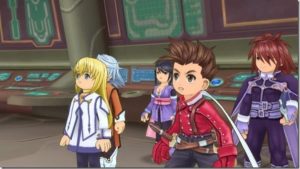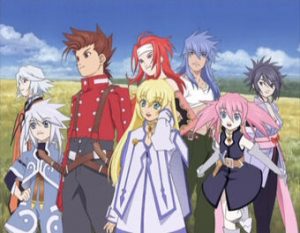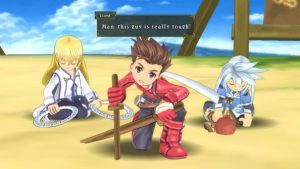Table of Contents
- TL;DR Explanation: Why is Tales of Symphonia so Popular?
- Top Reasons for Tales of Symphonia’s Popularity
- Wrap Up
I think it’s time for another Tales of Symphonia post. Honestly, though, my watch might be broken, because it always says it’s time for another Tales of Symphonia post.
The next topic I’m going to tackle is the game’s popularity. If you’re just coming across the game, you might be wondering why Tales of Symphonia is so popular, especially given that most other games in the Tales series weren’t as well-known outside of Japan.
I can’t speak for everyone who played the game, but I can give you my perspective as a fan. It should give you some idea of why so many people like this JRPG.
TL;DR Explanation: Why is Tales of Symphonia so Popular?
In case you don’t have time to read all my reasons, let’s gloss over them quickly. Tales of Symphonia has a number of factors contributing to its popularity.
To start with, it has an extremely relevant focus on racial discrimination that’s extra important today. It’s also an easy-to-understand plot (unlike many other JRPGs, which are notoriously convoluted), the characters are fun, and the real-time combat system is a blast.
Last, I think nostalgia plays a key in the affection fans continue to have for the game. It came out in 2003, and some gamers look back to that era as a simpler time in the world of gaming.
See Also: Why is Tales of Symphonia Multiplayer?
Top Reasons for Tales of Symphonia’s Popularity
It has a relevant theme and message.
In the United States, racial inequality has been a big topic recently. I won’t go into that, because I don’t think this is the place for that discussion, but Tales of Symphonia has a message that’s very applicable to the modern times.
The whole plot of the game occurred as a result of the intense oppression and discrimination experienced by half-elves. This becomes a key catalyst through many of the conflicts in the game, with the final boss battle culminating in a discussion on discrimination and how to resolve the divides between the races.
Of course, there are no easy solutions. But this topic remains important throughout the game, and I think it has lessons in it that are very pertinent today.
The story is easy to follow.

If there’s one thing JRPGs are known for (aside from crazy outfits and hair), it’s the extremely messy storylines. Some series are famous for how difficult it is to make heads or tails of their plots.
This is where Tales of Symphonia shines. Although some critics felt that it was filled with clichés and predictable turns, the game still has an easily understandable story. It does a good job of easing you into the world and introducing you to new concepts.
I first played the game as a young kid. Even then, despite having a childish attention span, I had no problems grasping the story. It kind of makes the game a breath of fresh air.
Most of the cast is pretty likeable.

JRPGs tend to have casts of characters that fit within narrowly defined tropes. There’s almost always a bubbly girl that cheers everyone up; a gritty protagonist with a traumatic past; a strong, silent guy; and a guy who’s a little bit too flirtatious. The list could go on, but these are your staples in Japanese games and in anime.
Don’t get me wrong – you see these same character archetypes in Tales of Symphonia. However, the game doesn’t limit its characters to their tropes. Each one has a background and depth to them that goes beyond the two-dimensional molds you see other series using.
Every single character is lively and has their ups and downs. They have fun conversations with each other and seem to legitimately care about each other. At the end of the game, I left feeling as if I had made friends with each one.
See Also: Tales of Symphonia Characters Ranked: the Definitive Ranking
It has a unique combat system.

In many RPGs, the standard was a turn-based combat system. Rather than everyone moving simultaneously, characters would take turns attacking one at a time.
This is not so in Tales of Symphonia. It has a real-time and linear combat system, meaning all characters can attack, cast spells, or move at the same time. You can move either towards or away from enemies – hence, where the term “linear” comes from, because you can basically only move left or right.
The real-time combat gives each battle an energetic feel. I would say the linear movement is a little frustrating and limiting at times, but I still have fun in most of the battles.
Nostalgia.
Tales of Symphonia was released in 2003, which was a bit of a golden age in terms of gaming. The beloved Pokemon series saw the American release of Ruby and Sapphire versions, The Legend of Zelda: Wind Waker came out, and we saw the emergence of Silent Hill 3. There are tons of other amazing games that were published at the time, too, but this is just a small sample of what gamers were so hyped about.
In other words, 2003 was a fan-freaking-tastic year for gaming. Aside from a series of amazing titles being released, times were simpler then. When you paid for a game, you got the whole game without a need for DLC.
Nowadays, games are cut into pieces and sold in expensive slivers. Many are nostalgic for a time when quality seemed higher and you got what you paid for (without hidden expenses), and Tales of Symphonia represents that time.
Wrap Up
I think Tales of Sypmhonia’s popularity is very well-deserved. It has a fun combat system, lovable characters, a meaningful story, and tons of hours of gameplay.
There was so much content and story to explore, in fact, that it originally came on two GameCube discs. (It was actually kind of intimidating having to switch to the second disc while the console was still on!)
This seems especially crazy now, since our storage capabilities are so much better. I recently downloaded Tales of Symphonia on my PC, and was shocked to find that it’s actually only 7 GB.
If you haven’t played it already, I strongly recommend giving the game a chance. I don’t think you’ll regret it.
